Role
UX Researcher/Designer
Timeline
10 Hours - UX Challenge
Team
UX Researcher/Designer
Skills
User Research
Interaction Design
Visual Design
Wireframing & Prototyping
The Problem
Active travelers often arrive unprepared for climate or altitude changes. This impacts performance and delays their fitness routines.
Project Goals
- Allow users to instantly compare temperature and altitude between their home location and travel destination.
- Help fitness tourists adjust quicker to new environments so they can resume training with minimal disruption.
- Design a simple and intuitive experience for travelers to input locations and view relevant environmental differences.
Target Audience
- Runners, cyclists, hikers, gym-goers, and yoga practitioners who prioritise staying active while on holiday.
- Travellers engaging in high-altitude activities (e.g., trekking, skiing, mountain biking).
- Individuals who aim to maintain healthy routines (hydration, diet, exercise) during their travels.
Research
Online Research taken for Aclimatize Me Now App
Based on online research, users are likely to engage in exercises such as yoga, squats, push-ups, lunges, chair dips, and stretching to help reduce the effects of jet lag while flying to their holiday or vacation destination. These exercises may also support the body’s adjustment to changes in altitude or temperature, helping users acclimate more comfortably. Additionally, users are more inclined to take part in fitness-oriented activities such as running, skiing, swimming, cycling, surfing, and climbing once they reach their destination.
Demographic insights suggest that young professionals, business owners, and health-conscious individuals are among the most likely to seek out these types of active holidays or vacations.
When it comes to altitude training, it’s essential that users follow a recommended set of exercises before engaging in any high-altitude activities. Jumping straight into intense physical exertion without proper acclimatisation can increase the risk of altitude sickness.
To support users in preparing for altitude differences, a helpful guide could be introduced. This would offer step-by-step advice to follow both before departure and while at the destination—ensuring a safer and more enjoyable fitness experience.
Regarding heat acclimation, research shows that users benefit from exercise sessions lasting 60 to 90 minutes, followed by cool-down periods. These may include slowing down the activity, taking regular breaks, and staying hydrated—helping the body adjust to higher temperatures gradually.
Expanding on this, an informative guide could be developed for both hot and cold environments. This guide would help users adapt to temperature changes by offering practical exercise advice and safety tips they can follow before and during their trip, especially before starting physical activities.
Design Solution
User Persona
The image above details a user persona named Jade McGowan, a 27-year-old female fashion shop owner based in New York City, NY. With a background in BA Fashion Design and BSc Business Management, Jade's life is a blend of entrepreneurial spirit and a love for travel and fitness. Her interests include cycling, running, and exploring new destinations with her boyfriend and friends. Jade's primary goals revolve around being prepared for her travels by knowing the temperature and altitude differences of her destinations in advance. Her pain points highlight the frustration of not having immediate access to such information, which hinders her ability to dive right into fitness activities upon arrival. She seeks an app that consolidates this data, providing comprehensive pre-travel guidance. Jade prefers using Samsung and Apple devices, and leverages various social media platforms like Instagram, X (formerly Twitter), LinkedIn, and TikTok to promote her business. Her content preferences include services like Tripadvisor, Airbnb, and Google Maps, while her brand influences span across major companies like Samsung, Google, and Apple. Jade is motivated by a desire to discover new places, engage in fitness activities during her travels, and achieve relaxation on her vacations, facing challenges in temperature and altitude acclimatisation and the need for exercise readiness in new locations.
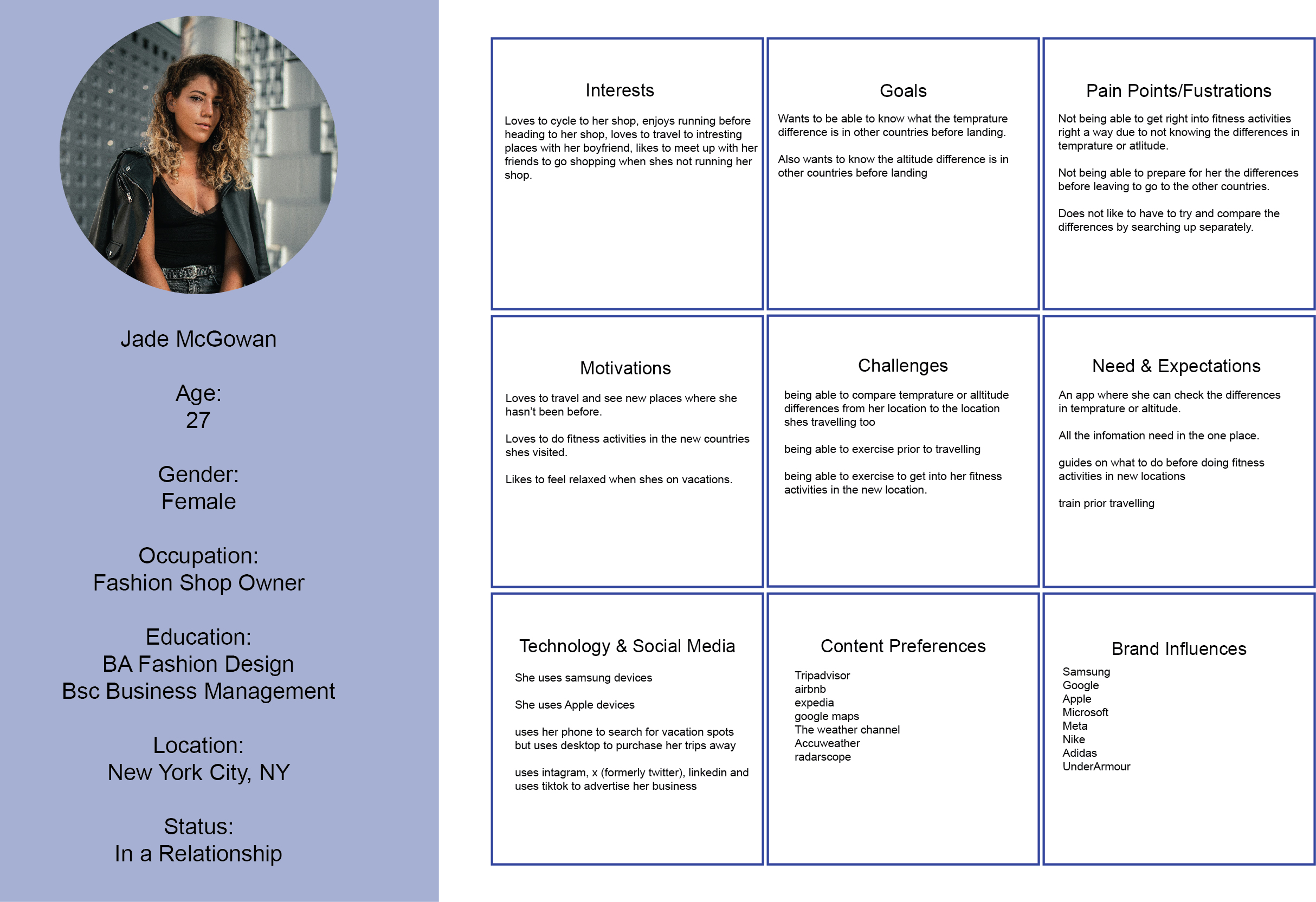
The image to the right illustrates the desired outcomes of a solution tailored for travellers like Jade McGowan. It should allow users to compare temperatures and altitudes across different countries in one accessible platform. The solution must support both pre-travel and on-location exercise options to help maintain fitness routines. User-friendliness is key, ensuring it’s easy for anyone to use. Live updates on temperature changes are essential, as is reliable functionality in high-altitude locations.
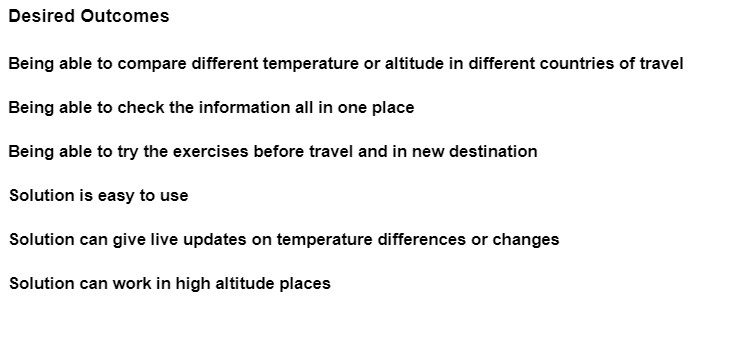
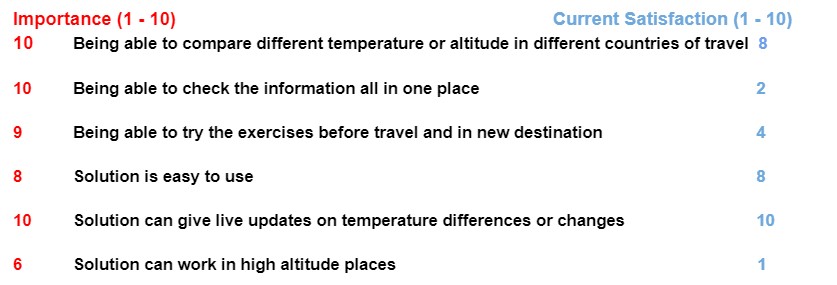
The image on the left presents a clear overview of how users rate the importance of various desired outcomes in a travel-related solution, alongside their satisfaction with existing options. Each outcome is scored on a scale from 1 to 10 for both measures. This visual comparison highlights key areas where current solutions succeed and where they fall short, helping to prioritise improvements based on real user needs.
The image on the right identifies key areas for enhancing a travel-related solution, based on a scale from 0 to 10—where higher scores indicate greater potential for improvement. These insights are informed by earlier comparisons of feature importance versus user satisfaction. Features like live temperature updates and overall ease of use received high satisfaction ratings, resulting in a score of 0, meaning little need for immediate improvement. In contrast, the most significant gap lies in consolidating all travel information into one central location. While users rated this feature as highly important (10), satisfaction was notably low (2), positioning it as the top priority for future development.
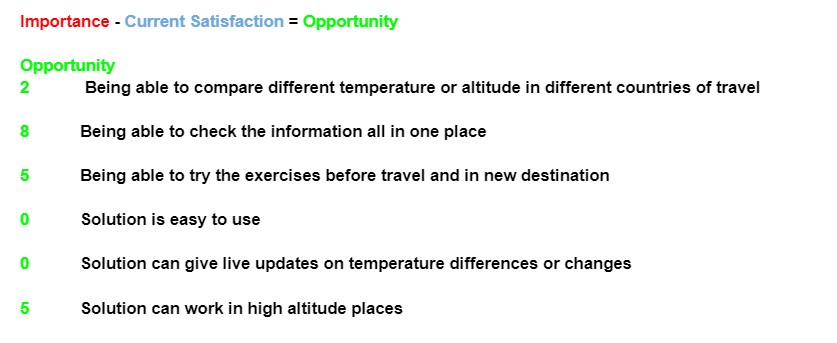
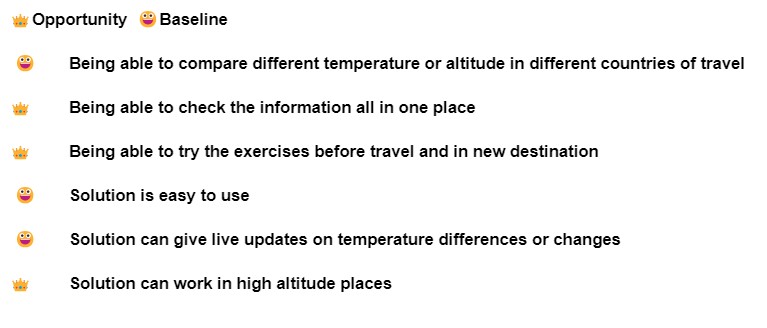
The image to the left highlights the gap between the app’s current baseline and potential opportunities for improvement. While features like ease of use and live temperature updates are meeting user expectations, other areas show clear room for growth. Key opportunities include bringing all travel information into one place, providing guided exercises before and during travel, and ensuring the app functions in high-altitude locations. Comparing temperature or altitude across countries also presents moderate potential. These insights guide future improvements by showing where the app can better meet user needs.
Desired Outcomes Analysis
The analysis highlights three key areas where the travel app could be significantly improved: integrating all travel-related information into a single, accessible platform; providing more effective exercise options both before and during travel; and ensuring reliable performance in high-altitude environments. While these features are highly valued by users, satisfaction with them remains low. In contrast, functions such as comparing temperatures or altitudes, user-friendly navigation, and real-time temperature updates are already meeting user expectations. Addressing the weaker areas has strong potential to elevate the overall user experience.
Brainstorm Design Solution
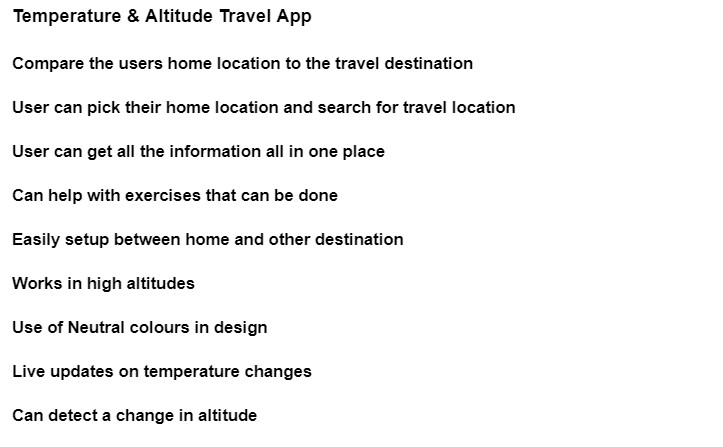
The Temperature & Altitude Travel App is designed to support users by allowing them to compare conditions between their home location and travel destination. Users can select their home base and search for their intended destination, with the app seamlessly integrating all relevant information in one convenient place. It offers tailored exercise recommendations for both pre-travel preparation and in-transit activity, and allows effortless switching between home and destination views. Optimised for high-altitude environments, the app features a neutral, calming design, delivers real-time temperature updates, and includes altitude change detection to keep users well-informed throughout their journey.
Success Metrics
Number of successful compares with destinations (home locations and look ups on other countries locations)
User reviews of the app
App user engagements such as installs, active usage, and uninstalls Amount of time it takes to install and set up app
Storyboard
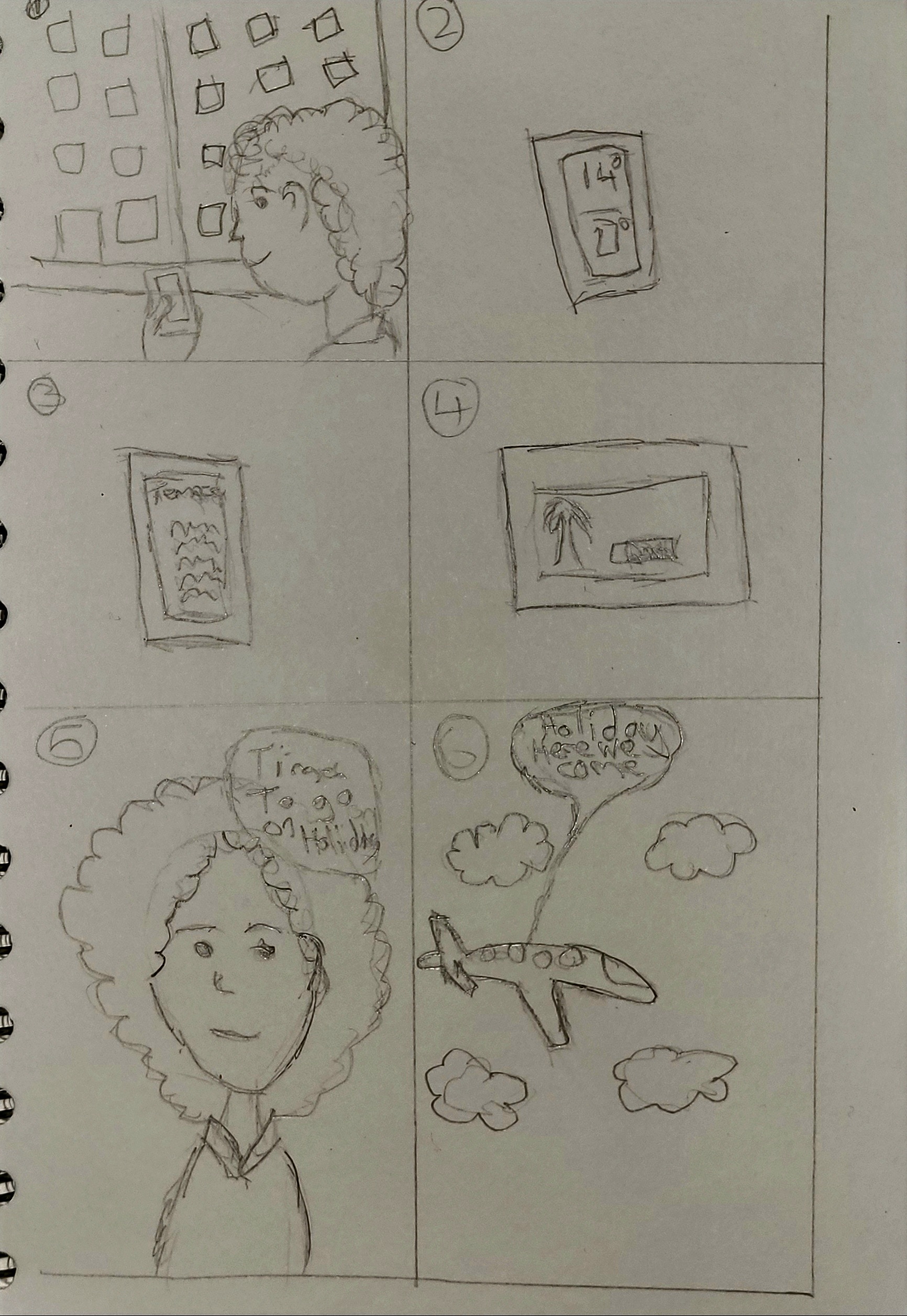
The storyboard illustrates a user planning their holiday with the help of a travel app. In the opening frame, the user launches the app on their phone. The second frame reveals a comparison of temperature differences between the user’s home and their chosen destination. This is followed by a third frame displaying detailed weather information specific to the travel location. The fourth frame captures a scenic view of the destination, adding visual appeal. In the fifth frame, the user appears excited, thinking, “Time to go on holiday.” The final frame shows an aeroplane in flight, accompanied by the user’s thought, “Holiday, here we come!” This sequence effectively showcases the app’s role in delivering key travel insights while building anticipation for the journey.
User Flow

The user flow chart outlines the steps for using the travel app. It starts with the user opening the app. They are then asked to allow the app to access their location. After granting permission, the user selects their home location. Next, they find their holiday or vacation destination. The app then compares the temperature or altitude difference between the home and travel locations. Finally, the user can look at information about exercises to do before and during the trip. This process ensures the user gets all the necessary travel details in a simple and organised manner.
Wireframes
The wireframes for the "Acclimatize Me" app reveal a clean, intuitive interface aimed at helping users adapt to new environments with ease. The home screen features a globe graphic alongside clear options for selecting a home or destination location. Users can choose the nearest location from a curated list and compare temperature and altitude data between their current and future destinations. The app also includes dedicated guides offering practical tips and information on symptoms to monitor in varying environmental conditions. Overall, the design prioritises straightforward navigation and easy access to essential travel insights.
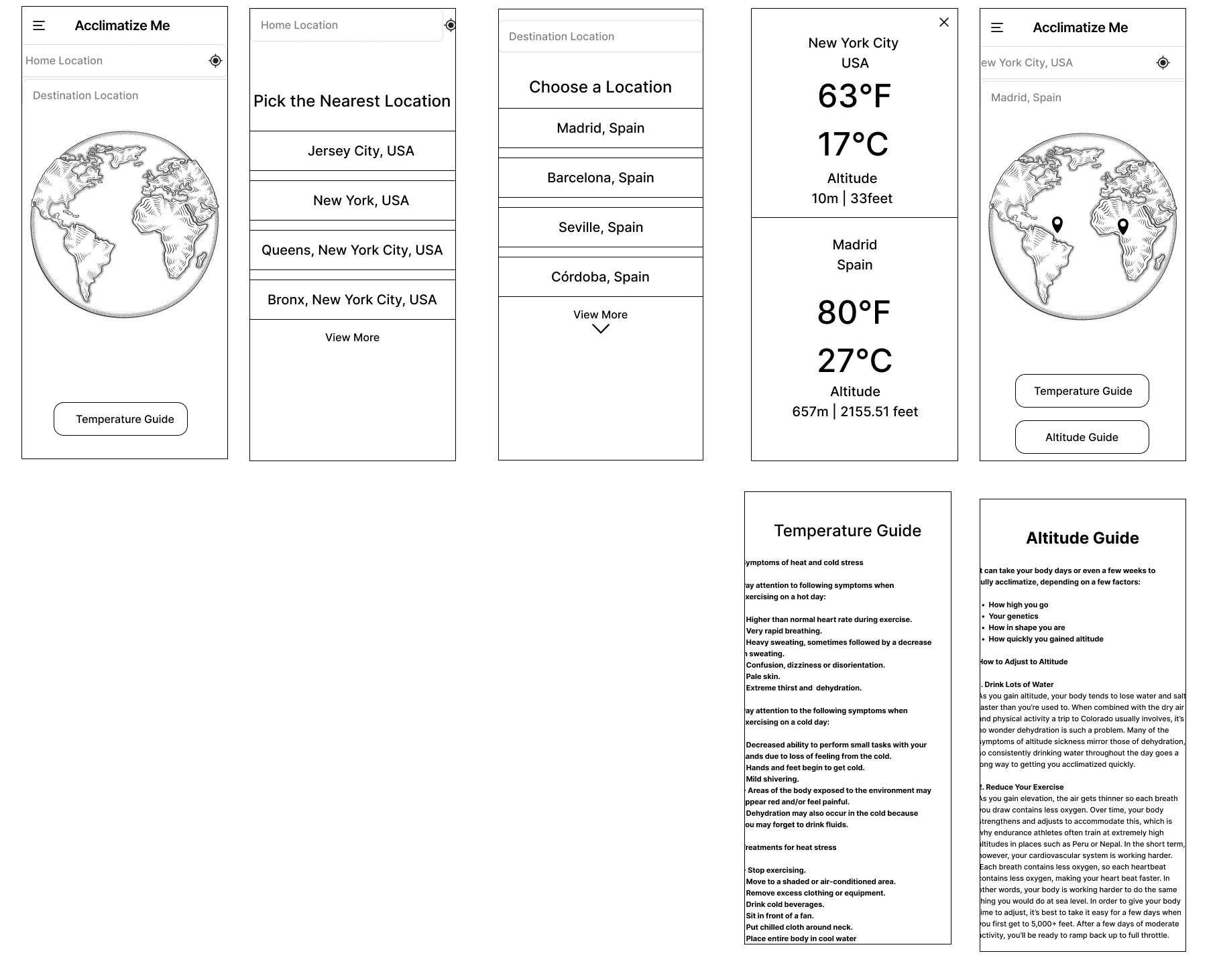
Results
The interactive prototype for the "Acclimatize Me" app offers a comprehensive preview of the app’s core functionality and user experience. It allows users to navigate the home screen, select their closest home location, and choose a travel destination to compare temperature and altitude differences. The prototype features fully functional buttons and interactive links, enabling access to the Temperature and Altitude Guides, which provide practical tips and health advice for various conditions. Users can seamlessly explore how the app supports safe and informed travel by simulating real-world scenarios. The design emphasises clarity, ease of use, and quick access to vital information, ensuring that even first-time users can engage confidently. This hands on experience reinforces the app’s purpose: to help users adjust smoothly to unfamiliar environments through an intuitive, informative, and supportive interface.
Reflection
This UX challenge offered valuable insights into the core needs and common pain points faced by travellers, particularly when adjusting to unfamiliar environments. The resulting app, Acclimatize Me, was designed to address these challenges by consolidating essential travel information into a single, accessible platform. It supports users with tailored exercise recommendations, reliable performance in high-altitude conditions, and a thoughtful interface that promotes ease of use. The soft pastel colour palette, complemented by a deep brown accent, contributes to a calm, welcoming experience that puts users at ease. Wireframes illustrate a clean and intuitive layout, with a home page centred around a globe graphic and clear options for selecting home and destination locations. Users can easily compare temperature and altitude differences, while accessing practical guides on environmental adaptation. The high-fidelity prototypes reflect a refined, polished interface with smooth navigation and clearly presented information. The interactive prototype brings these features to life, allowing users to explore the app’s full functionality and better understand how it supports acclimatisation. Moving forward, I plan to revisit this project, incorporating user feedback to further refine and enhance the app's design and overall experience.